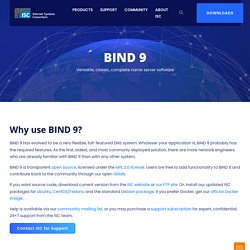

DNSDB. Access to the DNSDB web interface is offered to qualified individuals on a per-user basis.

In order to request an account, please submit an account application form and it will be reviewed. In general, web interface access is offered on a public benefit basis to members of the white hat security community. The web interface must not be used for automated or bulk queries; please contact us via email at dnsdb@isc.org if you would like to request access to the bulk API. Documentation for the bulk API is available here . The web interface limits searches to a maximum of 10,000 results, while the API interface defaults to the same limit while providing the ability to increase the number of results returned.
The web search interface offers two lookup modes, RRset and Rdata , which are selected between using the radio buttons at the top of the search form. The RRset search mode's bailiwick field specifies a filter on the "bailiwick" metadata field attached to RRset results. DNSDB@ISC - Resiliency and Security Forum. The DNS Database (DNSDB) is a searchable history of DNS records that stores and indexes both the Passive DNS data, available via ISC’s Security Information Exchange, as well as the authoritative DNS data that various zone operators make available. DNSDB makes it easy to search for individual DNS records as seen as different levels of the DNS tree hierarchy along with timestamps for when they were first or last seen.
More importantly, DNSDB provides the ability to perform inverse look-ups based on the answers of DNS queries. This database is frequently used as a resource for finding sources used for malicious activities. Some of its many uses include: Finding new domains related to existing spam or botnet campaigns. Sharing DNS information broadens results from other data analysis, maps out related criminal activity, and identifies the DNS names or addresses used by cyber criminals.
For more information, visit. Which F-root node am I using? F-root. DiG HOWTO. Initial publication: August 31, 2004 Most recent revision: May 11, 2006 How to use dig to query DNS name servers. dig is a command-line tool for querying DNS name servers for information about host addresses, mail exchanges, name servers, and related information.

The dig(1) man page is somewhat lacking when it comes to examples, a shortcoming this article tries to remedy. The source code for dig is part of the larger ISC BIND distribution. If you’re looking for information on configuring the BIND name server, you might find my article BIND for the Small LAN more to your taste. Understanding the default output The most typical, simplest query is for a single host. . $ dig www.isc.org That’s the command-line invocation of dig I used. ; <<>> DiG 9.2.3 <<>> www.isc.org ;; global options: printcmd The opening section of dig’s output tells us a little about itself (version 9.2.3) and the global options that are set (in this case, printcmd). ;; QUESTION SECTION: ;www.isc.org.
Dig www.isc.org AAAA +short. BIND. An authoritative DNS server answers requests from resolvers, using information about the domain names it is authoritative for.

You can provide DNS services on the Internet by installing this software on a server and giving it information about your domain names. The BIND 9 documentation includes a description of the Primary/Secondary/Stealth Secondary roles for authoritative servers. Response Rate Limiting (RRL) is an enhancement to named to reduce the problem of “amplification attacks” by rate-limiting DNS responses. This feature is on by default because it has proven to be so effective; it’s now even more effective with DNS Cookies, which focus rate-limiting on unknown clients.
DNS cookies, per RFC 7873, are exchanged between client and server to provide IP address identity, helping to prevent attacks using forged IP addresses. Minimal ANY Responses Queries for ANY records are a possible abuse mechanism because they typically extract a response much larger than the query. HSM Support.